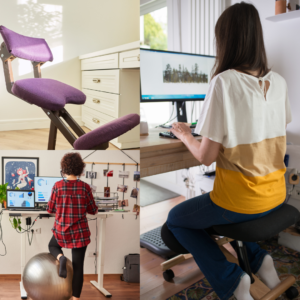How to Sit on Office Chair While Pregnant: A Comprehensive Guide
Pregnancy brings many changes to your body and daily routines. One often overlooked aspect is how to sit on office chair while pregnant. Proper posture and seating habits become crucial during this time. This guide will help you navigate the challenges of office chair comfort and ergonomics throughout your pregnancy.
The Importance of Proper Seating During Pregnancy
Firstly, understanding why sitting correctly matters is essential. Your growing belly shifts your center of gravity. This change can strain your back and pelvis. Learning how to sit on office chair while pregnant helps prevent discomfort and potential health issues.
Common Challenges Pregnant Women Face with Office Chairs

Before diving into solutions, let’s examine the problems. Many pregnant women experience:
1. Lower back pain
2. Swollen feet and ankles
3. Reduced circulation
4. Difficulty finding a comfortable position
5. Increased pressure on the bladder
These issues often stem from improper seating. Now, let’s explore how to address them.
Adjusting Your Office Chair for Pregnancy
Firstly, familiarize yourself with your chair’s features. Most office chairs offer various adjustments. Here’s how to optimize them:
1. Seat Height: Adjust so your feet rest flat on the floor.
2. Seat Depth: Ensure 2-3 inches of space between the edge and your knees.
3. Backrest: Set it to support your lower back’s natural curve.
4. Armrests: Position them to keep your shoulders relaxed.
Making these adjustments is crucial in learning how to sit on office chair while pregnant.
Proper Posture: The Key to Comfort
Next, focus on your posture. Follow these guidelines:
1. Sit with your back against the chair.
2. Keep your shoulders relaxed.
3. Maintain a 90-degree angle at your hips and knees.
4. Avoid crossing your legs.
5. Keep your computer screen at eye level.
Remember, good posture reduces strain on your body.
Additional Support: Cushions and Accessories
Furthermore, consider using extra support. Some helpful items include:
1. Lumbar cushion: Supports your lower back.
2. Footrest: Improves circulation and reduces swelling.
3. Seat cushion: Adds comfort and reduces pressure.
4. Wrist rest: Prevents carpal tunnel syndrome.
These accessories can significantly enhance your comfort.
Taking Breaks: The Importance of Movement

Moreover, sitting for long periods isn’t ideal during pregnancy. Take regular breaks to:
1. Stand up and stretch
2. Walk around the office
3. Do simple exercises at your desk
4. Practice deep breathing
These activities promote circulation and reduce discomfort.
Ergonomic Alternatives to Traditional Office Chairs

Additionally, consider alternative seating options. Some pregnant women find relief with:
1. Exercise ball chairs
2. Kneeling chairs
3. Standing desks (used intermittently)
4. Ergonomic stools
Experiment to find what works best for you.
How to Sit on Office Chair While Pregnant: Trimester-Specific Tips
First Trimester:
1. Focus on establishing good habits early.
2. Pay attention to any discomfort and address it promptly.
3. Begin incorporating regular breaks into your routine.
Second Trimester:
1. Adjust your chair as your body changes.
2. Consider using a small pillow for lower back support.
3. Be mindful of your growing belly when reaching for items.
Third Trimester:
1. Use additional cushioning as needed.
2. Take more frequent breaks.
3. Listen to your body and rest when necessary.
Communicating with Your Employer
Next, don’t hesitate to discuss your needs with your employer. Many companies are willing to provide:
1. Ergonomic assessments
2. Special equipment
3. Flexible work arrangements
Open communication ensures you have the support you need.
Exercises to Complement Proper Sitting

Additionally, incorporate these exercises into your routine:
1. Pelvic tilts
2. Shoulder rolls
3. Ankle rotations
4. Neck stretches
These movements can be done discreetly at your desk.
Hydration and Nutrition: Supporting Your Seated Comfort
Moreover, pay attention to your diet and fluid intake. Proper hydration and nutrition can:
1. Reduce swelling
2. Improve circulation
3. Boost energy levels
4. Support overall comfort
Keep a water bottle at your desk and choose healthy snacks.
Dressing for Comfort in the Office

Furthermore, your clothing choices can impact your comfort. Opt for:
1. Loose, breathable fabrics
2. Comfortable maternity pants or skirts
3. Supportive, low-heeled shoes
4. Layers to accommodate temperature changes
Comfortable clothing complements your efforts to sit properly.
Managing Common Discomforts While Seated
Even with proper techniques, you may experience discomfort. Here are some tips:
1. For back pain: Try gentle stretches or use a heating pad.
2. For swollen feet: Elevate them when possible.
3. For heartburn: Sit upright and avoid reclining after meals.
4. For leg cramps: Flex your feet and stay hydrated.
Address discomfort promptly to prevent it from worsening.
Preparing for Your Return to Work Post-Pregnancy
Finally, consider how your seating needs may change after pregnancy. Plan for:
1. Nursing or pumping accommodations
2. Gradual return to full-time sitting
3. Postpartum body changes
Anticipating these needs ensures a smoother transition.
Conclusion: Mastering How to Sit on Office Chair While Pregnant
In conclusion, learning how to sit on office chair while pregnant is crucial for your comfort and health. By adjusting your chair, maintaining good posture, using supportive accessories, and taking regular breaks, you can create a comfortable work environment. Remember to listen to your body, communicate with your employer, and make adjustments as your pregnancy progresses. With these strategies, you can navigate office life successfully throughout your pregnancy.
